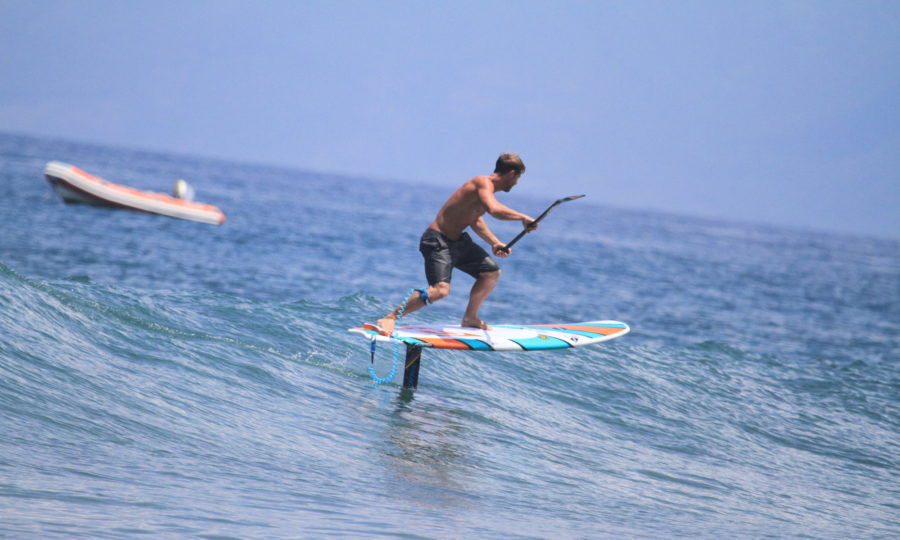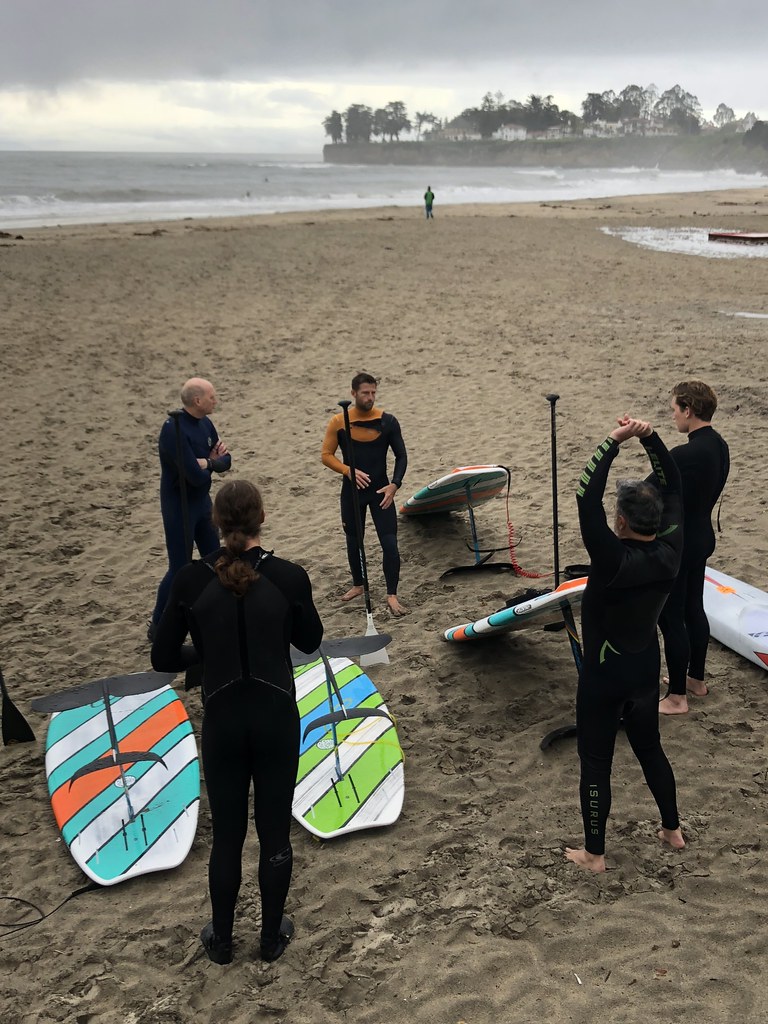Overview
- Step 1: Guests questionnaire & waiver
- Step 2: Distribute equipment and give lesson outline to guest
- Step 3: Paddle out without foil to get comfortable on boards, and familiar with lineup
- Step 4: Provide thorough safety and equipment handling briefing
- Step 5: Demonstrate proper flying technique on land
- Step 6: Assist guests into water and begin flying
- Step 7: Assist guest out of the water, disassembly of foils
- Step 8: High fives and good byes!
SUP and Surf hydrofoil Lesson Outline
Sign UP: Guest completes waiver form and questionnaires
- Have you ever rode a hydrofoil before?
- How much experience do you have with traditional surfing and/or Sup surfing
- What equipment do you typically use to surf and/or sup surf on, size, width and most importantly comfortable volume?
- What kind of conditions do you prefer to surf and/or sup surf in?
Pre-Requisites
- Guests must have the ability to comfortably catch waves on their own surfboard or sup surfboard to sign up for foil clinic/lessons. I am willing to offer sup surfing lessons or traditional surf lessons to help the guests get to that level, however it is not possible to combine a sup surfing lesson with a hydrofoil lesson in the session.
- Lesson/clinic will begin with introductions on the beach. During this time the instructor will make sure all guests are properly fitted with the ideal board, paddle, they will be foiling on.
- The instructor will then determine and show each guest where they need to position their feet when foiling on the board they will be using, to make things simple I will refer to this foot position as the “sweet spot”
- After demonstrating where each guests “sweet spot” is on the board, the instructor will then take the guest into the water without the foil on the board to allow the guests to get comfortable on the board they will be foiling with.
- The instructor will also help the guest get familiar with the lineup identifying any hazards such as shallow spots in the surf, rocks, steep sections, or crowds, of course the instructor will also identify where the idea spot is to paddle out, rest between waves, and what area of the lineup we intend to foil. After guests have demonstrated understanding of the lineup, ability on board including ability to catch a wave in the manner we plan to when foiling we will then head back to the beach to assemble masts to boards, provide safety instruction, handling instructions, and flying instructions, before heading back out to the water where we will be foiling for the rest of the scheduled lesson/clinic time.
- During trip back to the beach instructor will introduce some basic foil terminology to help the guests get familiarized with the equipment they will be using (wing, mast, fuselage, tail stabilizers, lift, cavitation) while the instructor assembles foil to boards. (I plan to pre-assemble guests foils so only the mast is left to screw in)
- Provide a thorough safety briefing including handling instructions for the foil.
Safety instructions
- Re-Inform guests of the lineup intended to be foiled, re-identify any hazards such as shallow spots in the surf, rocks, steep sections, or crowds, also re-identify where the idea spot is to paddle out, rest between waves, and what area of the lineup we intend to foil
- Ask guests to please always follow safety instructions to insure theirs and everyone else’s safety in the water.
- Please allow instructor to help you enter and exit the water with foil gear during clinic/lesson.
- Once in the water with the foil on allow the instructor to demonstrate where to position yourself in line-up and how to catch wave with foil before guests first wave, show guests where to wait between rides and establish an order to begin in, for safety its important that we start foiling one at a time, and avoid letting everyone paddle out to their own peak or spot in the lineup
- In the event of wipeout or fall the safest way to fall is backward, this is because typically this sends the board in front of you with the wave which will likely prevent the guest falling on the foil itself during wipeout/fall.
- Instill in guests to make sure you have a clear runway to fly, try to maintain at least 20 feet of space from others in the water at all times when catching a wave and/or flying.
Handling instructions
- Demonstrate the preferred way to carry the board with foil which is to hold board backwards with paddle in strong hand (typically right hand) and foil mast in other hand so you can walk into the water with foil in front of you. Carry board out into waist deep water if possible before placing foil in the water, if this is not possible due to surf or shallow depth place board foil up on the surface and walk/swim out until you have reached a depth of at least 3 feet or approx. 1 meter.
- Instruct guests to leave boards foil up on beach before and/or after session
- Instructor will help every guest individually enter and exit the water with foil, instructor will gladly offer to carry equipment in and out of water if guest is not capable or confident.
- It is important for the instructor to appropriately convey how fragile the foil parts are to minimize damage to equipment from guests throughout the session.

Flying instructions
- Demonstrate to guests proper foot positioning according to determined “sweet spot” which I believe is the foundation to successful flight. Demonstrate how moving feet and weight back and forth can help increase or decrease lift. Demonstrate how being ahead of the “sweet spot” will not allow lift and this should be considered your “safe spot” on the board.
- Demonstrate to guests how to control foil lift by properly distributing weight from front foot to back foot as necessary. Instruct guests to keep weight centered and avoid any side-to-side leaning. I like to tell guests imagine you have walls on each side of your board, and the goal is to keep your body from leaning side-to-side to avoid touching those walls.
- Instruct guests to always keep eyes up looking forward when flying. Balance is greatly affected by your gaze which is pretty universal for all board-sports, especially in foiling.
Foil time
- After safety, handling and flying instructions have been covered on the beach, we will then re-enter the water one at a time and paddle out to a pre-determined spot in the water where the guests can safely wait on their boards, the instructor will then demonstrate where and how to catch waves to foil.
- After I ride one wave demonstrating the proper foot positioning and weight distribution I will then begin helping guests catch and fly on the waves one at a time.
- I believe the best advice given to me when I first started was “don’t try to fly” so I will instruct the guest to catch at least one wave in their “safe spot” without attempting to fly, before stepping back into their “sweet spot” to fly.
- In between rides, instructor will provide positive and constructive feedback and advice to guests
- Instructor needs to be mindful of all guest’s physical conditioning and abilities, making sure all guests are having fun and given an equal amount of riding time and instruction. The instructor needs to pace the lesson so the guests do not wear themselves out in the first 30 minutes. “It’s all about the experience!”
- Guests will kindly be informed when the lesson time is coming to an end about 15 minutes prior to the end of the scheduled time, the guests will be informed how and when to exit the water to ensure safety and care of equipment.
High fives and good byes
- Once all guests and equipment have safely exited the water, guest will be shown how to properly dis-assemble the foil, guests will also be given additional handling and maintenance advice on how to properly care and store foils.
- Finish all lessons/clinics with contact exchange and group photo!

→ Josh Riccio Instagram